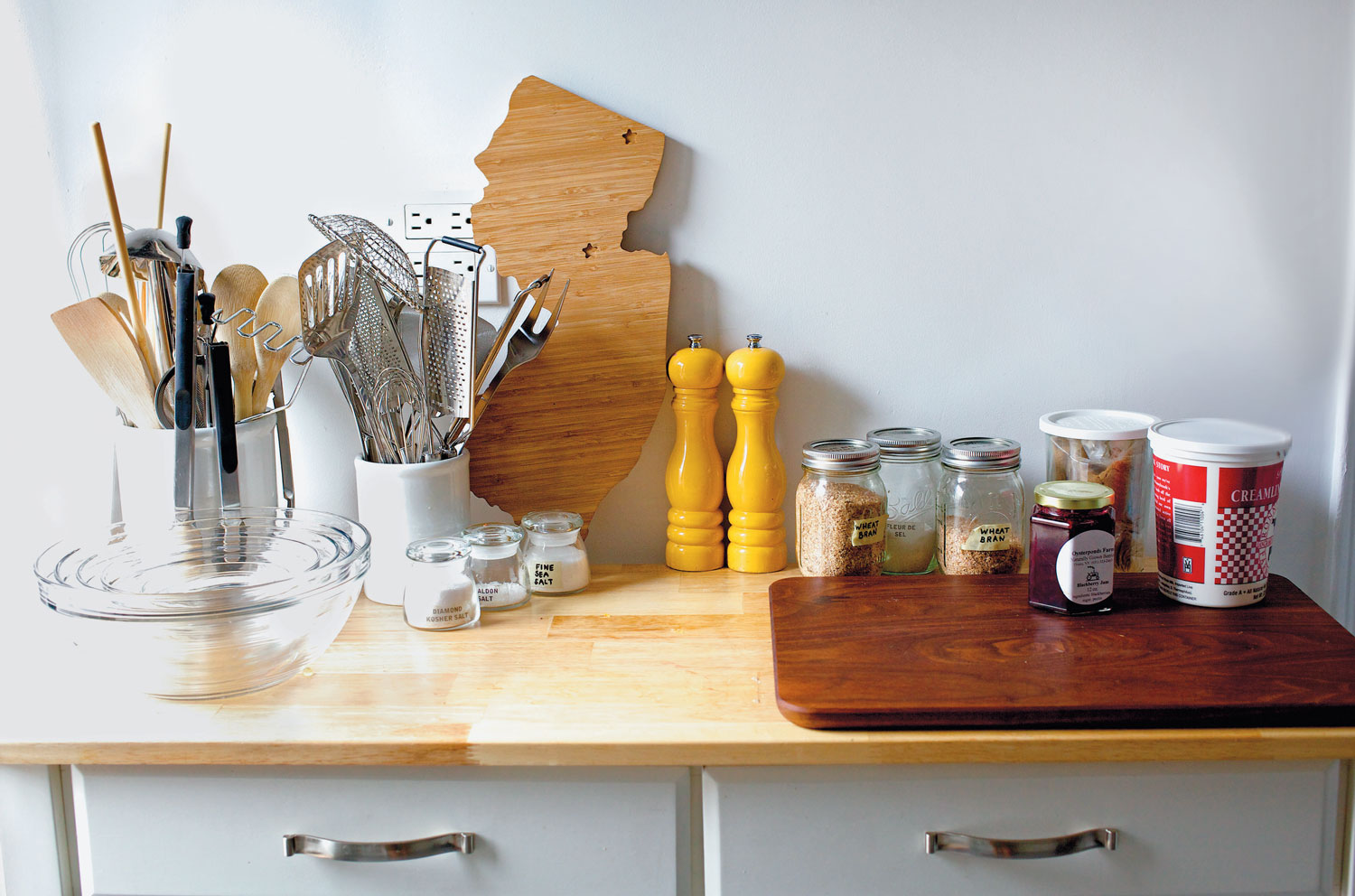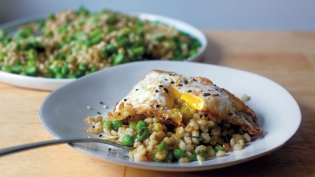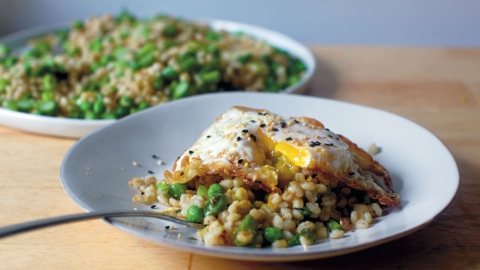America’s Favorite Companion
A chat with Smitten Kitchen’s Deb Perelman
The beauty of home cooking lies in its ability to be delicious, unpretentious and—dare we say—triumphant, all at the same time.
That’s the conviction explored by beloved food blogger and Jersey native Deb Perelman, with her trademark wit, in her second cookbook: Smitten Kitchen Every Day: Triumphant & Unfussy New Favorites (Knopf, 2017).
It’s a mission she has brought to millions of Smitten Kitchen blog readers since 2006, an unheard-of run in the fickle turbulence of the internet. There’s a reason they’re hooked. Perelman’s lack of pretense is apparent the moment you speak with her. She’s as charming in real life as she is online, in her blog posts or filming videos for her new digital Food Network series. Case in point: During our interview, I shared that a friend had sorrowfully missed a stop on Perelman’s book tour, wildly pregnant at the time. At that, she joyfully burst out: “Does that mean she has a baby now? Aww . . . send her my congratulations, that’s exciting!”
Perelman’s new book is an indispensable guide for new moms, home cooks looking for a refresh and anyone who believes that a few extra minutes in the kitchen is worth it—if it will result in something delicious. She also opens up about her own journey to “get her culinary mojo back,” as a mom of two kids. As she writes in the book’s introduction: “Quickly, half our family (ahem, the noisier half ) needed square meals at predictable times and I, well . . . I began to understand why not everyone jumps for joy when it’s time to make dinner.”
The book that results is full of beautifully photographed recipes that make a delicious case for a return to the kitchen.
A theme in your new book is getting your culinary groove back. Any advice?
Think about what you want to eat. You would think that this would be the first thing that came into our heads, but if you read food media and cookbooks, there’s all this other stuff. There’s this idea that you should be defining your cooking by scientific measurements. This isn’t to say that we don’t all need this, to have that at the back of your head.
At the front of your head should be: ‘What do I really want to eat for dinner? What is something that is never right when I pick it up from the store premade, or order it from take-out? It’s funny that it seems scandalous and rare, but I just wanted to chase food that we’re excited about. I’m trying to save us from feeling like cooking has to be another chore that we endure. We all have enough things on our to-do list every day. It would be a shame that something that could be so pleasurable to become another item on a to-do list.
What I always want to know is: When did the ‘shoulds’ show up? I talk to people and it’s like: ‘My kid doesn’t want to eat this and my husband doesn’t want to eat this.’ I’m like, man, that would kill it for me too. I get it.
Do you think we get too aspirational?
I don’t know why we think that the restaurant kitchen is the place to look for home cooking. There are exceptions: cookbooks written by chefs that have been co-written by somebody who really spends a lot of time in a home kitchen. But a lot of what we like about restaurant cooking is—I love the fact that I can have this burrata salad with one vinaigrette in a puddle of another one, and also this crunchy slaw. That’s like five recipes! I’m so happy to outsource that.
Now let me tell you what you can do with a recipe with only two sections.
You spend a lot of time interacting with your audience in blog comments. What drives you?
There are so many stories that don’t get told in this chef-driven, restaurant-driven narrative, while people are cooking at home every day. So, I love hearing how you made it: Did it work out as you thought it would? How did you tweak it? What would you not bother with next time? What was absolutely worth the time? If people let me interrogate them after they told me they made a recipe, that’s what I would do, every time. [Laughs.] What does your mom think? Who was suspicious? Were they won over? Did your kids eat it? I want to hear it all.
There’s natural curiosity.
When someone tells me there’s a ten-ingredient recipe, I’m like: What was the eleventh? Which one didn’t make the cut? I want to hear the story not being told. Because maybe I have it. Maybe I can put it in!

“I grew up
in New Jersey.
I don’t have
any airs about
food at all.”
Which culinary triumphs stand out from your own life?
For me, the triumphant part is really just this idea that you come home and you’re tired. Why would you cook? I’m happy to eat a peanut-butter-and-jelly sandwich quite often. It’s fine. But sometimes you think: ‘But wait.’
There’s a recent recipe on the site, this chickpea pasta with tomato paste that becomes this very quick Pasta con Ceci. I’ve heard from so many people that come home and are like: ‘Eh, I don’t want to cook.’ But then they’re like: ‘Wait! I have a can of chickpeas. I have dried pasta. I have a tube of tomato paste.’ Then they’re like: ‘It’s so good. Look at what I made!’ You want to do a victory lap around the kitchen.
You just took something that you were completely not in the mood to do and turned it into your favorite part of the day. I chase those moments.
All of the sudden there’s this magical dish . . .
And it’s excellent. And you haven’t had it before. And it tastes special. It’s comforting and wholesome. For me, that’s a really big part of it. It’s a lot easier to market a five-ingredient cookbook than these long paragraphs about feeling triumphant in the kitchen. But that’s . . . what I think about when I think about what makes us happy.
Does being from NJ influence your cooking?
I’ve lived in New York for a long time, but if your upbringing is in New Jersey, I think that’s really where your head is at. I certainly get a lot of food in New York City, which is very interesting. But your idea of what food comes from when you were growing up at the table. I grew up in New Jersey [in Chatham]. I don’t have any airs about food at all.
Is there a dish that defined your family growing up?
I was thinking recently about beef bourguignon, saying I’d like to refresh . . . We mostly just ate regular food: chicken, rice, salads, spaghetti and meatballs. My mom’s family is German. Her dad only wanted to eat brisket, noodles and cabbage. So that’s all my mom ate growing up. Then she met my dad and he lived in New York City. He like Chinese food and Szechuan. He was eating all this stuff that my mom hadn’t been introduced to. She turned on the TV one day, and there was Julia Child, “The French Chef.” My mom said: ‘That’s it. That’s what I want to cook!’ Beef bourguignon wasn’t something we had all the time. [It] was the “company” dish. But I want to have a thing with it again.
Are there other influences that shaped your palate?
My grandparents ended up moving out to California. They lived there for most of my childhood, and we would always go out and visit. My mom loved the California produce. My son recently figured out that all of grandma’s favorite foods begin with “A:” arugula, apricot, asparagus, artichoke, avocado. I could just keep going. It’s the funniest thing. So, you take the California thing, and you take the French thing, and the way I cook makes a little bit more sense.
Which of your cookbooks are most dog-earned?
Well, obviously: Joy of Cooking. I’ve always loved the Moro and Ottolenghi cookbooks. [Try: Moro The Cookbook, Casa Moro and Moro East by Sam and Samuel Clark; and Jerusalem, Plenty or Plenty More by Yotam Ottolenghi.] I’ve always loved The Silver Spoon It’s this completely warmth-free Italian encyclopedia of a book, but I use it all of the time. When I’m trying to come up with a recipe for lasagna, it’s good to know what a classic lasagna might be: no-frills, no fuss.

Your Jersey cutting board that’s pictured in the introduction to your new book: functional or decorative?
[Laughs.] It’s supposed to be decorative, but it has been used a couple of times, so it looks kind of busted now and it needs some love. It was supposed to be hung on the wall and it never was, so it’s basically like everything else in my apartment: “Yeah. We should do something with that. Maybe we’ll do something else though.” But I love it.
Which kitchen items are musts for you? Which can people ditch?
We all tend to keep too much on our counters, and I do this too. Every so often I’ll be looking and I’ll be like: ‘Oh my god. The creep has happened. The creep of objects!’ Stuff I keep that isn’t particularly practical: I have an electric citrus juicer, and I love it so much. I actually just upgraded. Both times I was pregnant, I had this major citrus obsession. If I can get a bag of oranges in December? I don’t care what quality they are, they taste amazing juiced. And then you have fresh-squeezed orange juice! So good, and of course don’t forget margaritas.
Speaking of summer, you write in the books about your love for MOGO in Asbury Park.
I love that place so much! When you think of fusion food, you generally think of the worst strip-mall bad cheffing. Terrible ideas put together, but these are Korean fusion tacos that somehow work. We had to stop going this summer. You can’t go. it’s too busy now!
Any Jersey food experiences you love?
There’s amazing Indian food in Edison. If I even start listing, I’m going to get so many angry emails.
What ingredients do you think about when you think about spring?
Asparagus. Rhubarb. I always feel like those are the harbingers of spring. Then very shortly after you see some strawberries. Peas. Sugar snaps. And then it’s just this explosion. It’s more than you can carry in and all of your arms and all of your bags. And of course, ramps, which I know have become a foodie punching bag. But I love them, so I don’t care. I don’t care about your food trends. I like them! They’re good!
Any recipes in the new book that readers should seek out come spring?
They should make the spring fried barley in the new book, which I know has a funny name, but it was one of these ideas that I obsessed over for a couple of years. It was just this idea of taking fried rice, and you make it with barley instead. It sounds like: ‘Why would you do that? What are you trying to prove?’ But it crisps up really nicely in a pan. You can use peas, you can use asparagus. All of those green vegetables go really nicely with a soy-garlic-ginger finish.






